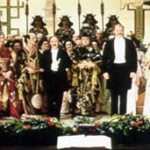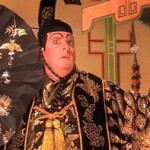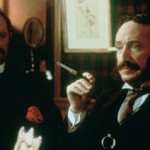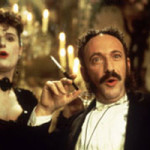While Topsy Turvy may well be a drama at heart and a musical in practice, by its very nature it has to be classified as a biopic here. It is, as my micro review correctly stated:
Mike Leigh‘s take on Gilbert & Sullivan creating The Mikado is beautifully conceived and performed at every level. The operatic sequences are as good as any you will ever see, Jim Broadbent’s Gilbert is nothing short of genius, and Alan Corduner’s Sullivan not far behind.
At first sight this may appear to be a distinct departure from the norm for Leigh, best known for improvised middle and working class dramas such as Abigail’s Party, Life is Sweet, Secrets and Lies, and the masterly Another Year, commonly made with Leigh’s own repertory company of distinguished actors, notably Alison Steadman, Timothy Spall, Brenda Blethyn, Lesley Manville, Jim Broadbent, Imelda Staunton, Jane Horrocks and more. Actors love the style in which the pieces are conceived and developed, and they love collaborating with Leigh, though it had previously only been tried out in a modern context.
In practice, the style works supremely well with real people in a real setting, both allowing the actors to develop characters and their motivations based on historical research. That they do so successfully is a testament to how effectively Leigh has marshalled and coaxed his troops into developing a credible drama, based often on their conceit and pomposity as much as their talent. Indeed, he could barely go wrong, given the rich panoply of eccentrics that surrounded the D’Oyly-Carte Opera Company – and here they are given due licence to display their eccentricities, for better or worse. They are depicted here lovingly and the script does them far more than justice – it is a veritable masterpiece.
It is worth drawing attention to Jim Broadbent and Alan Corduner, since they succeed in bringing to life the contrasting characters of Gilbert and Sullivan, a veritable chalk and cheese combination, often at one another’s throats, albeit in the most genteel of fashions. Broadbent’s Gilbert is a certainly a gentleman, master of his own fully-staffed house, husband to Kitty, and a grumpy old man to a tee. If ever any actor deserved a best actor Oscar, it is Broadbent for his astonishing portrayal of Gilbert. The movie won gongs for best make-up and costume design, but the actors were strangely overlooked. A travesty!
Sullivan was, by contrast, a bon viveur, a debonair maestro popular for his warmth in spite of testing Victorian morals to breaking point (he never married but did dally with a variety of mistresses, including liberal use of the bordellos of Paris.) Sullivan also suffered extensively from poor health, but this did not stop his prolific output, albeit not as the serious composer as which he most wished to be remembered. The movie highlights deliciously the differences between the two men, especially the fact that Gilbert refused to indulge Kitty, who was frustrated to the extreme in his unwillingness to give her a child, and Sullivan’s mistress becoming pregnant but having an abortion, and not for the first time.
You don’t have to like Gilbert & Sullivan operettas to enjoy the movie, though it certainly helps. But even if Sullivan’s music and Gilbert’s razor sharp and eternally witty libretto do not appeal, the quality of performances and how they evolve should be admired by all, none more so than Gilbert inviting three uncomprehending Japanese ladies from their Japanese exhibition to rehearsals in order to demonstrate to the actresses how he wants them to walk, in contrast to the manner rehearsed by the eccentric of a choreographer John D’Auban (Andy Serkis), whose professional sensibilities are severely wounded.
However, the one dimension that had to work if a G&S biopic were to hit the spot were the musical scenes. Employing actors who could sing and play beats overdubbing hands down, and to give the performers credit they do a brilliant job of both rehearsals and demonstrating stage craft – for that is how they need to act, as if to a real life audience and not to a camera.
But perhaps the movie works best as a running commentary on Victorian society and the many hypocrisies contained therein. The attention to detail is notable, with due credit to the production design team for recounting the minutiae. Of many nice touches, I love the impact of new technology, notably the way Gilbert and Barker interact on the telephone – both bellowing at each other and recounting the box office figures in code to prevent the operator overhearing. This view is echoes by comments from the critics, courtesy of Wikipedia:
In the United Kingdom, the film grossed £610,634 in total and £139,700 on its opening weekend. In the United States, the film grossed $6,208,548 in total, and $31,387 on its opening weekend. The film has an 89% rating at Rotten Tomatoes, and a 90 at Metacritic, indicating that critical reception was overall positive. According to Janet Maslin, Topsy-Turvy is “grandly entertaining”, “one of those films that create a mix of erudition,pageantry and delectable acting opportunities, much as Shakespeare in Love did:
Topsy-Turvy … is much bigger than their story. Its aspirations are thrilling in their own right. Mr. Leigh’s gratifyingly long view of life in the theatre (Gilbert has a dentist who tells him Princess Ida could have been shorter) includes not only historical and biographical details but also the painstaking process of creating a Gilbert and Sullivan production from the ground up. The film details all this with the luxury of a leisurely pace, as opposed to a slow one.
According to Richard Schickel, the film was “one of the year’s more beguiling surprises”; it is a “somewhat comic, somewhat desperate, very carefully detailed” story given “heartfelt heft” in the way it depicts how rehearsing and putting on an operetta “takes over everyone’s life.” According to Philip French, “Topsy-Turvy is not a conventional biographical film”; “the film is an opulently mounted, warm-hearted celebration of two great artists and of a dedicated group of actors, backstage personnel and front-of-house figures working together.” French also notes the film is “a rare treat, thanks to Dick Pope‘s photography, Eve Stewart‘s production design and Lindy Hemming‘s costumes”, with “great music orchestrated by Carl Davis.”
Topsy-Turvy ranks 481st on Empire‘s 2008 list of the 500 greatest movies of all time.
In many ways, this explains why the movie did not achieve great things at the box office but has most certainly earned cult classic status. It is one of those rare beasts, a film that repays viewing more than once, one of which at the very least should be devoted solely to the music and choreography. I hope you enjoy as much as I did!









